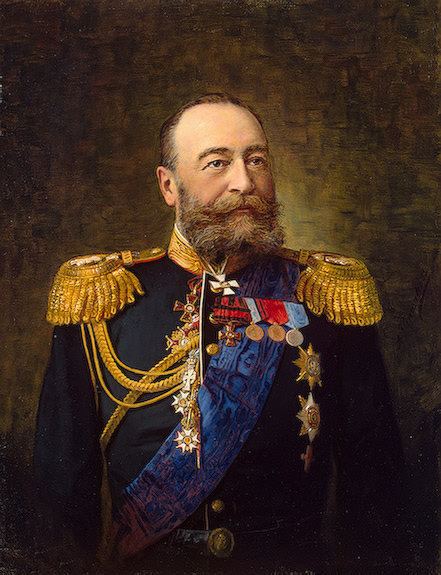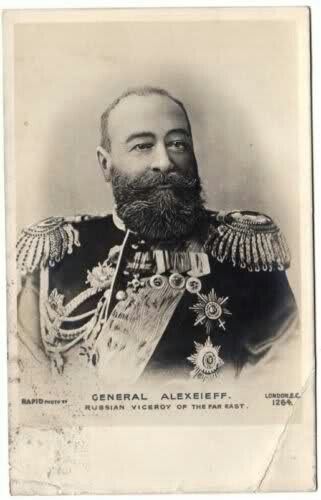Years of service 1859-1904 | Battles/wars Russo Japanese War Rank Admiral Name Yevgeni Alekseyev | |
 | ||
Native name Evgénii Ivánovich alekséev Similar People Nikolai Linevich, Ferdinand Hamer, Clemens von Ketteler, Zaiyi - Prince Duan, Song Qing | ||
Yevgeni Ivanovich Alekseyev or Alexeyev (Russian: Евге́ний Ива́нович Алексе́ев (May 23 [O.S. May 11] 1843 – May 27, 1917) was an admiral in the Imperial Russian Navy, viceroy of the Russian Far East, and commander-in-chief of Imperial Russian forces at Port Arthur and in Manchuria during the first year of the Russo-Japanese War of 1904-05.
Contents

Biography

Alexeyev was an illegitimate son of Tsar Alexander II, raised by the family of Lieutenant Ivan Maximovich Alekseyev (1796–1849) in Sevastopol.
At the age of 13, Alexeyev attended the Sea Cadet Corps and completed his training three years later. He was assigned as a midshipman for four years to the screw corvette Varyag, on a world tour. He was commissioned as an ensign in 1867. After serving on numerous ships in the Imperial Russian Navy, he was given his first command in 1878: the cruiser Afrika, which he commanded on a voyage around the world from 1880 to 1883. From 1883 to 1888 Alexeyev served as a naval attaché to France, and was promoted to the rank of captain in 1886. After his return to Russia in 1889, he was given command of the protected cruiser Admiral Kornilov. In 1891, he made another round the world cruise, this time accompanied by the Tsarevich Nicholas (the future Tsar Nicholas II). This was the Eastern journey of Nicholas II.
Alexeyev was promoted to rear admiral in 1892 and served on the General Staff of the Imperial Russian Navy, becoming vice admiral in 1894 and deputy chief-of-staff in 1895. From 1895 to 1897 he was made commander of the Russian Pacific Fleet, initially at Vladivostok, and from December 1897, from Port Arthur in the southern Liaodong Peninsula leased from Qing dynasty China. In 1898 he was appointed governor of the Kwantung Fortified Region, and was again named commander of the Russian Pacific Fleet from 1899. He participated in the suppression of the Boxer Rebellion as commander of an army corps, following an appointment by War Minister Aleksey Kuropatkin and was promoted to Adjutant general.
The failure of Russia to withdraw its forces from Manchuria after the end of the Boxer Rebellion further alarmed the Empire of Japan, still upset over the Triple Intervention and Russian de facto annexation of the Liaodong Peninsula and increasing Russian influence over Joseon dynasty Korea – all of which the Japanese deemed detrimental to their interests and national security.
Alexeyev was a key member of the “Bezobrazov Circle”, a politically motivated investment group organized by Aleksandr Mikhailovich Bezobrazov whose investors included many members of the highest level in the Russian court. The aim of the “Bezobrazov Circle” was the establishment of a commercial enterprise reminiscent of the British East India Company, which would reward its investors with financial benefits while setting the stage for the conquest of Manchuria and Korea. Alexeyev reassured the Tsar that increased aggressive action in the region would not provoke a military response from Japan.
On August 13, 1903, Tsar Nicolas II appointed Alexeyev as viceroy in charge of all civil and military authority over Russian possessions in the Far East, including Russian-occupied Manchuria, the Liaodong Peninsula, and Russia Amur Military District (present day Primorsky Krai). As viceroy, he was beyond the jurisdiction of any ministry and reported directly to the Tsar; however, his exact functions were poorly defined, and as stated by historian Ian Nish: "he himself was unclear about the extent of his autonomy... In any event Alekseyev, who already had been given in May very great powers of coordination, did not greatly welcome the new title and almost declined to accept it."
With the outbreak of the Russo-Japanese War on February 9, 1904, Alexeyev became commander of all Russian land and naval forces in the Far East. He assumed direct command over the Russian Pacific Squadron after the dismissal of Vice Admiral Oskar Stark until the arrival of Vice Admiral Stepan Makarov, and again after Makarov’s death until the appointment of Vice Admiral Nikolai Skrydlov.
On land, Alexeyev had serious and continual disagreements with General Kuropatkin, the former minister of war over the strategy employed against the Japanese and forced Kuropatkin to take a more aggressive position despite Kuropatkin’s insistence on assuming a defensive war of attrition until the completion of the Trans-Siberian Railroad, which would bring reinforcements and supplies. Following a direct order from the Tsar, Alexeyev left Port Arthur on May 5, 1904 for Mukden, and following the defeat at the Battle of Shaho, was relieved of his command and ordered back to St. Petersburg on October 12, 1904.
In June 1905, the post of viceroy was abolished, and Alexeyev became a member of the State Council of Imperial Russia. In his later years, he moved to Russian Armenia and worked as a school teacher. In April 1917, in the wake of the February Revolution and the abdication of the Tsar in March, he retired from public life. He died a few weeks later in Yalta, on 27 May 1917.
